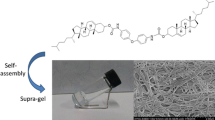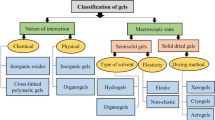Abstract
A dimeric-dehydrocholic acid derivative (DDAD) was synthesized and studied for its gelation ability in the potassium hydroxide solution. The DDAD-based gels were further investigated for their thermal stabilities and morphological structures by using the vial inversion method, transmission electron microscopy (TEM), scanning electron microscopy (SEM), and atomic force microscopy (AFM). Interestingly, the TEM and AFM images of the DDAD-based gels indicated that the supramolecular structures were composed of longer fibers. Importantly, Fourier transformation infrared spectra further revealed that the main driving forces in gel formation involve multiple hydrogen bonding, electrostatic, and dipole–dipole interactions among the gelator molecules. The X-ray diffraction analysis showed that the molecular packings in both the DDAD powders and the organogel phase were highly disordered. Based on these results, a mechanism for the formation of hydrogels is proposed. These findings present a novel hydrogelator and an insight into developing new types of gels as potential soft materials.







Similar content being viewed by others
References
Sangeetha NM, Maitra U (2005) Supramolecular gels: functions and uses. Chem Soc Rev 34:821–836
Donato RK, Migliorini MV, Benvegnú MA, Stracke MP, Gelesky MA, Pavan FA, Schrekker CML, Benvenutti EV Dupont J, Schrekker HS (2009) Synthesis of silica xerogels with highly distinct morphologies in the presence of imidazolium ionic liquids. J Sol-Gel Sci Technol 49:71–77
Chen XL, Liu LL, Liu KQ, Miao Q, Lü YC, Fang Y (2015) Compressible porous hybrid monoliths: preparation via a low molecular mass gelators-based gel-emulsion approach and exceptional performances. J Mater Chem A 3:24322–24332
Thubsuang U, Ishida H, Wongkasemjit S, Chaisuwan T (2014) Self-formation of 3D interconnected macroporous carbon xerogels derived from polybenzoxazine by selective solvent during the sol-gel process. J Mater Sci 49:4946–4961
Kirk W, Wessels W (2014) Electrophoretic mobility of weakly-charged (dipolar) hydrogels in water: contribution of hydrogen-bonding in the solvent dipole layer. J Colloid Interface Sci 416:294–305
Gao CG, Xue L, Chen YH, Li XY (2015) Supramolecular organogels based on perylenetetracarboxylic diimide trimers linked with benzenetricarboxylate. Colloid Polym Sci 293:35–48
Yang HK, Wang XX, Xiao H, Ma ZN (2016) Steroid-based A(LS)3-type gelators: probing the design criteria in creating soft materials. J Mater Sci 51:8529–8542
Yadav P, Ballabh A (2012) Synthesis, characterization and nano-particles synthesis using a simple two component supramolecular gelator: a step towards plausible mechanism of hydrogelation. Colloids Surf A: Physicochem Eng Aspects 414:333–338
Salazar-Bautista SC, Chebil A, Pickaert G, Gaucher C, Jamart-Gregoire B, Durand A, Leonard M (2017) Encapsulation and release of hydrophobic molecules from particles of gelled triglyceride with aminoacid-based low-molecular weight gelators. Colloids Surf A: Physicochem Eng Aspects 514:11–20
Geever LM, Higginbotham CL (2011) Temperature-triggered gelation and controlled drug release via NIPAAm/NVP-based hydrogels. J Mater Sci 46:3233–3240
Hoffman AS (2012) Hydrogels for biomedical applications. Adv Drug Deliv Rev 64:18–23
Chwalek K, Tsurkan MV, Freudenberg U, Werner C (2014) Glycosaminoglycan-based hydrogels to modulate heterocellular communication in vitro angiogenesis models. Sci Rep 4:4414
Park KM, Gerecht S (2014) Hypoxia-inducible hydrogels. Nat Commun 5:4075
Yang ZM, Xu B (2007) Supramolecular hydrogels based on biofunctional nanofibers of self-assembled small molecules. J Mater Chem 17:2385–2393
Döring A, Birnbaum W, Kuckling D (2013) Responsive hydrogels-structurally and dimensionally optimized smart frameworks for applications in catalysis, micro-system technology and material science. Chem Soc Rev 42:7391–7420
Cao XH, Zhao N, Lv HT, Ding QQ, Gao AP, Jing QS, Yi T (2017) Strong blue emissive supramolecular self-assembly system based on naphthalimide derivatives and its ability of detection and removal of 2,4,6-trinitrophenol. Langmuir 33:7788–7798
Cao XH, Zhao N, Zou GD, Gao AP, Ding QQ, Zeng GJ, Wu YQ (2017) A dual response organogel system based on an iridium complex and a Eu(III) hybrid for volatile acid and organic amine vapors. Soft Matter 13:3802–3811
Cao XH, Zhao N, Li RH, Lv HT, Zhang ZW, Gao AP, Yi T (2016) Steric-structure-dependent gel formation, hierarchical structures, rheological behavior, and surface wettability. Chem Asian J 11:3196–3204
Cao XH, Lan HC, Li ZH, Mao YY, Chen LM, Wu YQ, Yi T (2015) White light emission from a two-component hybrid gel via an energy transfer process. Phys Chem Chem Phys 17:32297–32303
Ren Y, Li CX, Lu Y, Wang XD, Zeng XS (2010) Aggregates of cholic acid and benzylamine as templates for the formation of hollow silica spheres. J Mater Sci 45:6830–6833
Xing PY, Chu XX, Du GY, Ma MF, Li SY, Hao AY (2014) Utilizing dual responsive supramolecular gel to stabilize grapheme oxide in apolar solvents. Colloid Polym Sci 292:3223–3231
Wang JY, Han YC (2011) Tuning the stop bands of inverse opal hydrogels with double network structure by controlling the solvent and pH. J Colloid Interface Sci 353:498–505
Khimani M, Verma G, Kumar S, Hassan PA, Aswal VK, Bahadur P (2015) pH induced tuning of size, charge and viscoelastic behavior of aqueous micellar solution of Pluronic® P104–anthranilic acid mixtures: a scattering, rheology and NMR study. Colloids Surf A: Physicochem Eng Aspects 470:202–210
Ran X, Wang HT, Zhang P, Bai BL, Zhao CX, Yu ZX, Li M (2011) Photo-induced fiber-vesicle morphological change in an organogel based on an azophenyl hydrazide derivative. Soft Matter 7:8561–8566
Hao X, Liu H, Xie YJ, Fang C, Yang HY (2013) Thermal-responsive self-healing hydrogel based on hydrophobically modified chitosan and vesicle. Colloid Polym Sci 291:1749–1758
Yang HK, Zhao H, Yang PR, Huang CH (2017) How do molecular structures affect gelation properties of supramolecular gels? Insights from low-molecular-weight gelators with different aromatic cores and alkyl chain lengths. Colloids Surf A: Physicochem Eng Aspects 535:242–250
Wei HL, Yao K, Chu HJ, Li ZC, Zhu J, Shen YM, Zhao ZX, Feng YL (2012) Click synthesis of the thermo- and pH-sensitive hydrogels containing β-cyclodextrins. J Mater Sci 47:332–340
Yu Y, Wang S, Jia L, Zhou MM, Pan QD, Zhai YC, Wang CS (2016) Organogels from different self-assembling novel L-proline dihydrazide derivatives: gelation mechanism and morphology investigations. J Sol-Gel Sci Technol 78:218–227
Yao CH, Sun Q, Xia W, Zhang J, Lin C, Wang LY (2017) Ferrocenyl-guest tunable organogel constructed from a pillar[6]arenefunctionalized cholesterol derivative. J Organomet Chem 847:68–73
Travaglini L, D'Annibale A, Schillén K, Olsson U, Sennato S, Pavela NV, Galantini L (2012) Amino acid-bile acid based molecules: extremely narrow surfactant nanotubes formed by a phenylalanine-substituted cholic acid. Chem Commun 48:12011–12013
Jung JH, Parka M, Shinkai S (2010) Fabrication of silica nanotubes by using self-assembled gels and their applications in environmental and biological fields. Chem Soc Rev 39:4286–4302
Löfman M, Koivukorpi J, Noponen V, Salo H, Sievänen E (2011) Bile acid alkylamide derivatives as low molecular weight organogelators: systematic gelation studies and qualitative structural analysis of the systems. J Colloid Interface Sci 360:633–644
Ghosh K, Panja S, Bhattacharya S (2017) Visual sensing of Ag+ ions through gelation of cholesterol-appended benzimidazole and associated ion conducting behavior. Chemistry Select 2:959–966
Ghosh K, Kar D, Panja S, Bhattacharya S (2014) Ion conducting cholesterol appended pyridinium bisamide-based gel for the selective detection of Ag+ and Cl– ions. RSC Adv 4:3798–3803
Banerjee S, Vidya VM, Savyasachi AJ, Maitra U (2011) Perfluoroalkyl bile esters: a new class of efficient gelators of organic and aqueous-organic media. J Mater Chem 21:14693–14705
Nonappa MU (2007) Simple esters of cholic acid as potent organogelators: direct imaging of the collapse of SAFINs. Soft Matter 3:1428–1433
Virtanen E, Kolehmainen E (2004) Use of bile acids in pharmacological and supramolecular applications. Eur J Org Chem 2004:3385–3399
Cravotto G, Binello A, Boffa L, Rosati O, Boccalini M, Chimichi S (2006) Regio- and stereoselective reductions of dehydrocholic acid. Steroids 71:469–475
Jeon HJ, Kang MK, Park C, Kim KT, Chang JY, Kim C, Song HH (2007) Supramolecular ordering of amide dendrons in lyotropic and thermotropic conditions. Langmuir 23:13109–13116
Yang HK, Wang XX, Yan YK (2016) Two-component dendritic gel: influence of the aromatic chain length on the organogel stability and supramolecular architecture. Colloids and Surfaces A: Physicochem Eng Aspects 497:72–80
Eldridge JE, Ferry JD (1954) Studies of the crosslinking process in gelatin gels. III. Dependence of melting point on concentration and molecular weight. J Phys Chem 58:992–995
Tran NB, Moon JR, Jeon YS, Kim JY, Kim JH (2017) Adhesive and self-healing soft gel based on metal-coordinated imidazole-containing polyaspartamide. Colloid Polym Sci 295:655–664
He PL, Liu J, Liu KQ, Ding LP, Yan JL, Gao D, Fang Y (2010) Preparation of novel organometallic derivatives of cholesterol and their gel-formation properties. Colloids and Surfaces A: Physicochem Eng Aspects 362:127–134
Wu JD, Lu JR, Hu J, Gao YX, Ma Q, Ju Y (2013) Self-assembly of sodium glycyrrhetinate into a hydrogel: characterisation and properties. RSC Adv 3:24906–24909
Bag BG, Dash SS (2016) Self-assembly of sodium and potassium betulinates into hydro- and organo-gels: entrapment and removal studies of fluorophores and synthesis of gel-gold nanoparticle hybrid materials. RSC Adv 6:17290–17296
Lan Y, Corradini MG, Weiss RG, Raghavanc SR, Rogers MA (2015) To gel or not to gel: correlating molecular gelation with solvent parameters. Chem Soc Rev 44:6035–6058
Buerkle LE, Rowan SJ (2012) Supramolecular gels formed from multi-component low molecular weight species. Chem Soc Rev 41:6089–6102
Funding
This work was funded by the Science Foundation of North University of China (No. XJJ2016015), the Open Research Fund of Key Laboratory of Functional Polymer Materials of Ministry of Education, Nankai University (No. 201603), the National Natural Science Foundation of China (No. 21503195), and Shanxi Provincial Foundation for Science and Technology Research (No. 201701D221090).
Author information
Authors and Affiliations
Corresponding author
Ethics declarations
Conflict of interest
The authors declare that they have no conflict of interest.
Electronic supplementary material
ESM 1
(DOC 493 kb)
Rights and permissions
About this article
Cite this article
Yang, H., Qi, P. & Zhao, H. A novel hydrogelator based on dimeric-dehydrocholic acid derivative. Colloid Polym Sci 296, 1071–1078 (2018). https://doi.org/10.1007/s00396-018-4324-9
Received:
Revised:
Accepted:
Published:
Issue Date:
DOI: https://doi.org/10.1007/s00396-018-4324-9




